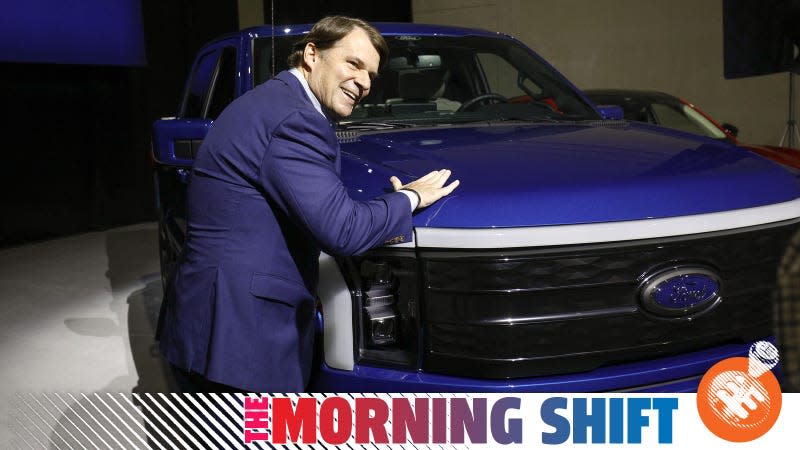The Federal Government Might Actually Close the MPGe Loophole Once and For All

The federal government is finally realizing not all electric vehicles are created equal, BMW’s sales were a little soft last quarter, and CarMax is doing alright. All that and more in this edition of The Morning Shift for Tuesday, April 11, 2023.
1st Gear: The Problem With MPGe
It might seem counterintuitive, but the uptake of electric vehicles from automakers is adversely affecting the average fuel economy of modern cars in the United States. EVs broadly lower fleet-wide figures, regardless of their size or the size of their batteries. That enables companies to push even thirstier internal-combustion models, while simultaneously propping up wasteful EVs like the GMC Hummer as a net good for the environment, when they objectively aren’t.
Read more
It’s a bad situation that stems from the Department of Energy awarding rather generous MPGe numbers to every EV. On Monday, the government finally proposed addressing that oversight. From Reuters:
DOE wants to significantly revise how it calculates the petroleum-equivalent fuel economy rating for electric and plug-in electric hybrids for use in the National Highway Traffic Safety Administration’s (NHTSA) Corporate Average Fuel Economy (CAFE) program.
The current system has not been updated in more than two decades.
“Encouraging adoption of EVs can reduce petroleum consumption but giving too much credit for that adoption can lead to increased net petroleum use because it enables lower fuel economy among conventional vehicles, which represent by far the majority of vehicles sold,” DOE said in its proposed regulation.
Miles Per Gallon equivalent (MPGe) ratings are determined by using values for national electricity, petroleum generation and distribution efficiency and driving patterns. [...]
The Alliance for Automotive Innovation, which represents major automakers, warned last year that lowering the values could have far-reaching implications and would discourage EV adoption.
You can imagine how the “Alliance of Automotive Innovation” — an industry lobby comprised of manufacturers and suppliers that stymies progress to protect corporate interests — feels about this measure. We’ve covered the AAI before, and it stands to reason it’d fight this tooth and nail, because it’s going to make life harder for its members. Here’s how the DOE’s proposal would impact EVs already on the market:
A Volkswagen ID.4 EV with a current 380.6 MPGe under CAFE would get 107.4 MPGe under the DOE proposal, while a Ford F-150 EV drops from 237.1 to 67.1 MPGe and Chrysler Pacifica plug-in hybrid falls from 88.2 to 59.5 MPGe.
The Natural Resources Defense Council and Sierra Club petitioned for the change in 2021, arguing “excessively high imputed fuel economy values for EVs means that a relatively small number of EVs will mathematically guarantee compliance without meaningful improvements in the real-world average fuel economy of automakers’ overall fleets.”
That’s the key here. Ford can just trot out the F-150 Lightning with its supposed 237.1 MPGe, and suddenly, the company doesn’t have to make the Escape or Bronco any more efficient — even though far more people are buying those — because the Lightning (and the Mustang Mach-E along with it) can carry the brand.
The National Highway Traffic Safety Administration is expected to soon offer new, more stringent Corporate Average Fuel Economy requirements. It’ll be interesting to see if all these regulatory changes taken together are more critical toward EVs, and how manufacturers scramble to comply with the law.
2nd Gear: Hyundai Will Spend a Fortune on EVs
The Korean auto giant announced Tuesday morning that it plans to spend $18.2 billion on EV development between now and 2030. By that time, the company expects to be pumping out 1.51 million EVs in its domestic facilities annually — an estimated 40 percent of its global production. Courtesy Bloomberg:
Hyundai said that by 2030, it expects to have 31 EV models across its suite of brands. It added that Kia will build a new plant to manufacture electric purpose-built vehicles in Hwaseong city south of Seoul. Kia is preparing to release a three-row seat electric SUV, the EV9, in Korea later this year while Hyundai plans to introduce the Ioniq 7 in 2024.
Tuesday’s announcement echoes what Hyundai has already outlined when it comes to investing for a greener future. Hyundai and Genesis have detailed plans previously to introduce at least 17 battery-powered EVs by 2030, alongside 14 from Kia, which should be a “huge enabler” to reach the company’s goal of 3.5 million annual EV sales in 2030.
Automakers and battery producers in Korea are also still trying to figure out how to navigate US President Joe Biden’s Inflation Reduction Act, which requires carmakers to build EVs in the US in order to be eligible for subsidies.
Hyundai has been lobbying US officials for tweaks to the bill considering it doesn’t have any operational plant dedicated to EVs in the US yet. The latest IRA guidance earlier this month showed little change on that front.
As for U.S. EV sales, it seems there’s really no alternative option to Hyundai getting a plant built on North American soil as quickly as possible. One will be going up in Georgia with an eye toward starting production in 2025. It’ll make cars for all three of the company’s brands: Hyundai, Kia, and Genesis.
3rd Gear: BMW Faces ‘Challenging Business Environment’
BMW noticed a slight decrease in sales over the first quarter of 2023. But it’s remaining hopeful for a better year overall, per the latest from Reuters, by way of Automotive News:
BMW said it delivered 588,138 BMW, Mini and Rolls-Royce vehicles in the first quarter, down 1.5 percent on the previous year, while full-electric vehicle sales rose 83 percent year-on-year to 64,647 vehicles.
By region, BMW only saw sales growth in the U.S., with an 11.1 percent increase to 81,877 unit sales.
Sales in China fell 6.6 percent, but the company said the Chinese economy was expected to stabilize over the course of this year.
A 1.9 percent fall in European sales was attributed largely to an export and production ban in the Russian market, where Chinese marques are benefiting from the exit by Western automakers.
BMW remained confident about its 2023 guidance despite a “challenging business environment,” the company said in a statement on Tuesday.
Fully electric models and “high-end premium” offerings are expected to bring the bulk of growth this year. That’s already bearing out for the company’s EVs, which have seen sales double to 55,979 across all markets in the first three months alone. If you’re BMW, you don’t want to know how many EVs Tesla sold over that same span.
4th Gear: Our Pain Is CarMax’s Gain
The terrible new-car market is helping the slightly-better-but-still-terrible used-car market, as CarMax’s surprisingly upbeat profit report on Tuesday indicated. From Reuters:
Shares of the Richmond, Virginia-based company were up by 6.56% at $70.18 in premarket trade.
CarMax had in December implemented a series of measures to help cut costs, such as slowing down on acquiring cars for its inventory, trimming marketing and capital expenses, and pausing hiring for its corporate office.
“Our deliberate steps to navigate the pressures facing the used car industry are driving sequential improvements in our business,” CEO William Nash said on Tuesday.
Demand for used cars was dented over the past year due to higher borrowing costs and soaring commodity and gasoline prices, weighing on CarMax’s results.
However, with leasing rates on the rise and new-car prices nearing the $50,000 mark, most consumers have no choice but to seek options in the used-car market, sustaining some demand.
CarMax’s adjusted profit of 44 cents-per-share beat analysts expectation for 24 cents-per-share. Thank goodness for the worst time to buy a new car probably ever. It’s the same situation that helped AutoNation also turn a profit at the end of last year.
5th Gear: Ferrari and Samsung
There’s not much meat to this one, but Ferrari has struck a deal with Samsung to incorporate the tech giant’s OLED panels in its future interiors. Take it away one last time, Reuters:
The South Korean company will develop “bespoke OLED technology display solutions” for the next generation of Ferraris, Chief Executive Benedetto Vigna said in a statement.
The heads of Ferrari and Samsung Display signed a memorandum of understanding in Asan, South Korea, for which no financial details were disclosed.
Vigna has previously said that as Ferrari is focusing investment on electrification, the company would use external suppliers for non-crucial components or software.
Ferrari plans to unveil its first fully electric car in 2025.
Sure, it might seem silly to be overly concerned with the fidelity of the screen in a Ferrari. But the thing about OLED panels is that, unlike cheaper LCD units, they’re not uniformly backlit. Rather, the pixels shut themselves off individually to display pure black. That makes a big difference in an instrument cluster!
Reverse: Apollo 13
On this day in 1970 — 53 years ago — Apollo 13 launched successfully from Cape Canaveral en route to the moon. Of course, it’s what would happen over the next six days that made this particular mission perfect Hollywood fodder.
Apollo 13 launches to the moon
Neutral: Gang’s All Here!

My birthday was a few weeks ago and my girlfriend gave me a Tarmac Works Mitsubishi Lancer Evolution VI rally car, allowing me to finally complete this 1/64-scale family I started maybe 20 years ago.
More from Jalopnik
Sign up for Jalopnik's Newsletter. For the latest news, Facebook, Twitter and Instagram.

 Yahoo Autos
Yahoo Autos 